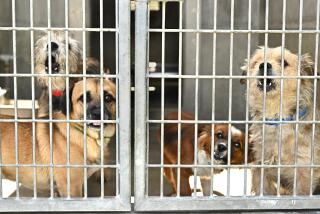L.A. County ordinance cracks down on ‘puppy mill’ abuses
“Puppy mills” are the factory farms of dog breeding — big and, all too often, neglectful and cruel. Female dogs are frequently overbred in back-to-back heat cycles to the point that their bones break and their teeth fall out. Hundreds, even thousands, of breeding dogs and puppies can end up crammed into filthy cages, according to animal welfare advocates, who have made numerous undercover videos of some of the worst abusers across the country.
But like factory farms, puppy mills are perfectly legal. They are subject to Animal Welfare Act standards so minimal that even the U.S. Department of Agriculture, which enforces them and licenses facilities, urges operators to exceed the standards. Shutting them down is difficult. In Missouri, where there are more commercial dog breeding facilities than anywhere else in the country, a ballot proposition that limited facilities to 50 breeding dogs was approved by voters last year but is now in danger of being dismantled by the state’s Legislature. A California bill calling for similar size restrictions passed both houses of the Legislature but was vetoed by then-Gov. Arnold Schwarzenegger in 2009. (He said that although he decried animal abuse, the bill went too far.)
If governments are having difficulty capping the number of animals a facility can handle, lawmakers can at least tighten oversight. That’s what the Los Angeles County Board of Supervisors did this week when it approved an ordinance, championed by Supervisor Michael D. Antonovich, that will more closely regulate anyone — breeders, groomers, operators of boarding kennels — housing more than just a few pets.
But the law’s stiffest requirements cover breeding facilities with more than 50 dogs, subjecting them to more frequent inspections by animal control officers, an extensive annual veterinary exam for each dog over 1 year old and increased minimum hours of staffing. (Facilities must be staffed 18 hours a day.) The law bans breeding of females under 1 year old. Three days before a dog gives birth, it must be separated from other adult dogs, provided with a nesting area to nurse and housed alone with its litter.
All animal facilities, no matter how big, must have working smoke detectors and fire suppression equipment. And all animals for sale must be microchipped or tattooed before they are sold or at 4 months old. “If we see sick animals, we want to be able to trace them back,” said Marcia Mayeda, the head of the county’s Department of Animal Care and Control, which is charged with enforcing the ordinance.
The new law is still not as strong as some animal welfare organizations would like. Dale Bartlett of the Humane Society of the United States notes that it doesn’t require that dogs rest between breeding cycles, though he says it is still a good and important ordinance.
The new regulations cover only unincorporated parts of Los Angeles County, an area that is not exactly a center of puppy mills. However, it was the discovery in 2008 of bad conditions, including severe overcrowding, at a facility in the Antelope Valley that spurred the creation of the county ordinance. There are currently six commercial facilities in rural areas, each with somewhere between 90 and 245 breeding females — and all of their puppies. So the number of animals affected is significant.
It’s doubtful that anyone intends to buy a puppy from a puppy mill when they go into a pet store, but animal welfare advocates contend that that is what happens. For the moment, it rests with local governments to tighten controls on large-scale commercial breeders. “Down the line we’re hoping that county legislators will look at this ordinance and say, ‘We can make this stronger,’ ” said Elizabeth Oreck, who runs the puppy mill initiative for Best Friends Animal Society.
For now, the county’s new law is a good move toward identifying and reforming neglectful breeding.
More to Read
A cure for the common opinion
Get thought-provoking perspectives with our weekly newsletter.
You may occasionally receive promotional content from the Los Angeles Times.






